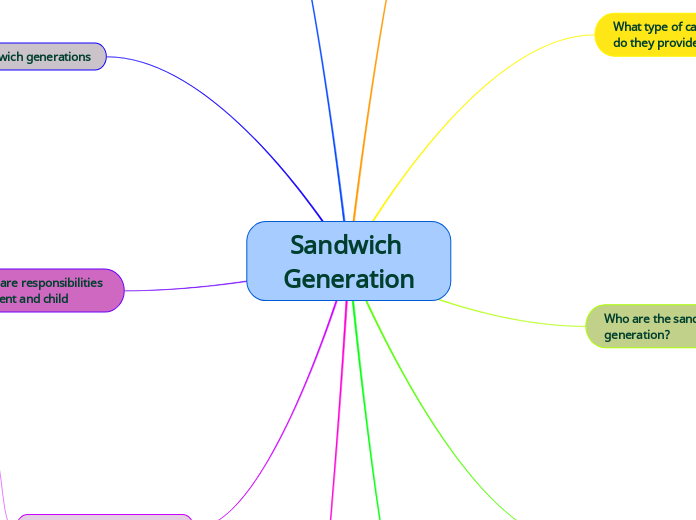Sandwich Generation
Timeline of the sandwich generation
In 1982, the Sandwich Generation officially began.
In that year, social worker Dorothy Miller first coined the term, “sandwich generation,” when referring to young women (in their 30s and 40s) who were raising young families while simultaneously taking care of their own aging parents.
Currently, statistics show that 47 percent of adults in their 40s and 50s are supporting an aging parent in their 70s while also managing their kids.
What type of care and support do they provide?
Canadians who are aged between 45 and 64 who are known as the "Sandwich Generation", provide 75% of informal types of care for older adults.
These people are supporting both their parents and their children at the same time and different ways. The kinds of support they give include and are not limited to: emotional, physical, financial, etc. This generation of people will be caring both for their own children, and their parents above them.
Nearly half (47%) of adults in their 40s and 50s have a parent age 65 or older and are either raising a young child or financially supporting a grown child (age 18 or older). And about one-in-seven middle-aged adults (15%) is providing financial support to both an aging parent and a child.
Who are the sandwich generation?
The sandwich generation refers to middle-aged adults (often in their 40s and 50s) who are caring for both elderly parents and their own children. There are nonprofits and government programs, like the Aging Life Care Association, designed to offer advice to both the elderly and their adult children.
There are all sorts of connotations connected with this terminology sandwich generation. For example, a peanut butter and jelly sandwich describes those caregivers that are stuck between aging parents and children. ... These same adult children often have their children living with them, some of them well into their 20s.
What are the financial costs?
Nearly one-third of sandwichers spend $3,000 a month or more to care for an aging parent or relative
34% spend $1,000 - $2,999 a month, and 35% spend less than $1,000.
The financial burden can be as heavy as the time commitment. Many estimate that they have lost more than $10,000 caring for their children and parents.
The Consequences on the Caregiver
Stress. The stress that this places on adults can be completely overwhelming. Especially if health problems develop with their aging parents.
There is something called caregiver burnout. Caregiver burnout consists of feelings of depression, guilt and isolation.
Issues finding the time to be a good spouse, parent, and child simultaneously.
Trouble managing work, hobbies, relationships and time for themselves.
Balancing their nuclear family life with their extended family life obligations
Caregivers may find it very hard to balance their parents lives and their children's lives together. It can become a serious struggle to be the main support on both ends.
Balancing this lifestyle takes someone who has responsibility and love for both their children and their parents. It is not an easy task to undertake.
Types of sandwich generations
The Traditional Sandwich Generation: This is the kind that is sandwiched between taking care of the parents, who need care and also taking care of their own kids.
The Club Sandwich Generation: This is the kind of generation who are in their 50s or 60s and are taking care of their ageing parents, their adult kids, and even their grandkids.
The Open-faced Sandwich Generation: This is the category of people that includes anyone who is involved in taking care of adults or elder care.
The shift of care responsibilities between parent and child
The caregiver has to learn to take care of their parents as though they were a child. This is a huge shift and can be extremely challenging emotionally.
Older parents become completely dependent on their younger children, and in this way, a huge shift occurs in support.
There is complete role reversal
Benefits to People involved
Caregiver has the unique opportunity to spend extra quality time with both elderly parents and children.
Caregiver can feel confident their aging parent is getting the love, support, and care they deserve as they age, so they can show them how much it meant to them that they cared for them this way when you were younger.
Caring for both helps to continue the closeness of the family, which shows children the value of these relationships and encourages them to continue.
Caregivers can help parents manage their health problems in ways that are respectful and meaningful to them as an individual because they know them, their wishes, and their opinions.
